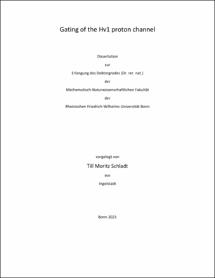Schladt, Till Moritz: Gating of the Hv1 proton channel. - Bonn, 2022. - Dissertation, Rheinische Friedrich-Wilhelms-Universität Bonn.
Online-Ausgabe in bonndoc: https://nbn-resolving.org/urn:nbn:de:hbz:5-66055
Online-Ausgabe in bonndoc: https://nbn-resolving.org/urn:nbn:de:hbz:5-66055
@phdthesis{handle:20.500.11811/9705,
urn: https://nbn-resolving.org/urn:nbn:de:hbz:5-66055,
author = {{Till Moritz Schladt}},
title = {Gating of the Hv1 proton channel},
school = {Rheinische Friedrich-Wilhelms-Universität Bonn},
year = 2022,
month = mar,
note = {Hv1 is a voltage-gated proton channel, which is involved in the regulation of the intracellular pH (pHi) in immune cells. Among the voltage-gated ion channels, Hv1 is unique because it lacks a classical pore domain and its voltage-sensor domain (VSD) also forms the pore. Thus, its pore structure, as well as the opening and closing of the pore (gating), differs from classical voltage-gated ion channels. Molecular mechanisms underlying gating, in particular the coupling of voltage sensing and pore opening, are not well understood. In this thesis I used targeted crosslinking of engineered cysteine side chains to measure interactions, distances, and distance changes between amino-acid side chains. 1,1-methanediyl bismethanethiosulfonate (MTS-1-MTS) was suitable for crosslinking specific cysteine side chains in transmembrane segments S1 (151C) and S4 (262C) in the closed state of the channel, which showed that the cysteine side chains approached 3-4 Å during gating. By combining crosslinking with patch-clamp fluorometry (PCF), I was able to show that crosslinking blocks the S1 gating movement. In further experiments, this combinatorial approach will contribute to our understanding of structure-function relationships in Hv1.
In Hv1, gating is controlled not only by membrane voltage but also by the difference between extracellular and intracellular pH (ΔpH), being coupled such that Hv1 opens only when the electrochemical proton gradient is outwardly directed. The coupling between voltage- and ΔpH-sensing is not understood at the molecular level. Here, I investigated the underlying molecular mechanism in PCF experiments by altering the ΔpH by means of perfusion or light- controlled proton release. I could show that a ΔpH change can induce conformational changes of S4 but not of S1. The results are consistent with the idea that S4 can sense both voltage and ΔpH. Furthermore, I could show that S4 of another voltage-sensitive protein (voltage-gated phosphatase, VSP) is not sensitive to ΔpH, indicating Hv1-specific structure-function relationships for ΔpH sensing.},
url = {https://hdl.handle.net/20.500.11811/9705}
}
urn: https://nbn-resolving.org/urn:nbn:de:hbz:5-66055,
author = {{Till Moritz Schladt}},
title = {Gating of the Hv1 proton channel},
school = {Rheinische Friedrich-Wilhelms-Universität Bonn},
year = 2022,
month = mar,
note = {Hv1 is a voltage-gated proton channel, which is involved in the regulation of the intracellular pH (pHi) in immune cells. Among the voltage-gated ion channels, Hv1 is unique because it lacks a classical pore domain and its voltage-sensor domain (VSD) also forms the pore. Thus, its pore structure, as well as the opening and closing of the pore (gating), differs from classical voltage-gated ion channels. Molecular mechanisms underlying gating, in particular the coupling of voltage sensing and pore opening, are not well understood. In this thesis I used targeted crosslinking of engineered cysteine side chains to measure interactions, distances, and distance changes between amino-acid side chains. 1,1-methanediyl bismethanethiosulfonate (MTS-1-MTS) was suitable for crosslinking specific cysteine side chains in transmembrane segments S1 (151C) and S4 (262C) in the closed state of the channel, which showed that the cysteine side chains approached 3-4 Å during gating. By combining crosslinking with patch-clamp fluorometry (PCF), I was able to show that crosslinking blocks the S1 gating movement. In further experiments, this combinatorial approach will contribute to our understanding of structure-function relationships in Hv1.
In Hv1, gating is controlled not only by membrane voltage but also by the difference between extracellular and intracellular pH (ΔpH), being coupled such that Hv1 opens only when the electrochemical proton gradient is outwardly directed. The coupling between voltage- and ΔpH-sensing is not understood at the molecular level. Here, I investigated the underlying molecular mechanism in PCF experiments by altering the ΔpH by means of perfusion or light- controlled proton release. I could show that a ΔpH change can induce conformational changes of S4 but not of S1. The results are consistent with the idea that S4 can sense both voltage and ΔpH. Furthermore, I could show that S4 of another voltage-sensitive protein (voltage-gated phosphatase, VSP) is not sensitive to ΔpH, indicating Hv1-specific structure-function relationships for ΔpH sensing.},
url = {https://hdl.handle.net/20.500.11811/9705}
}






